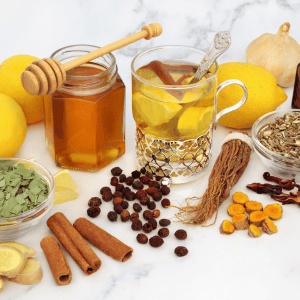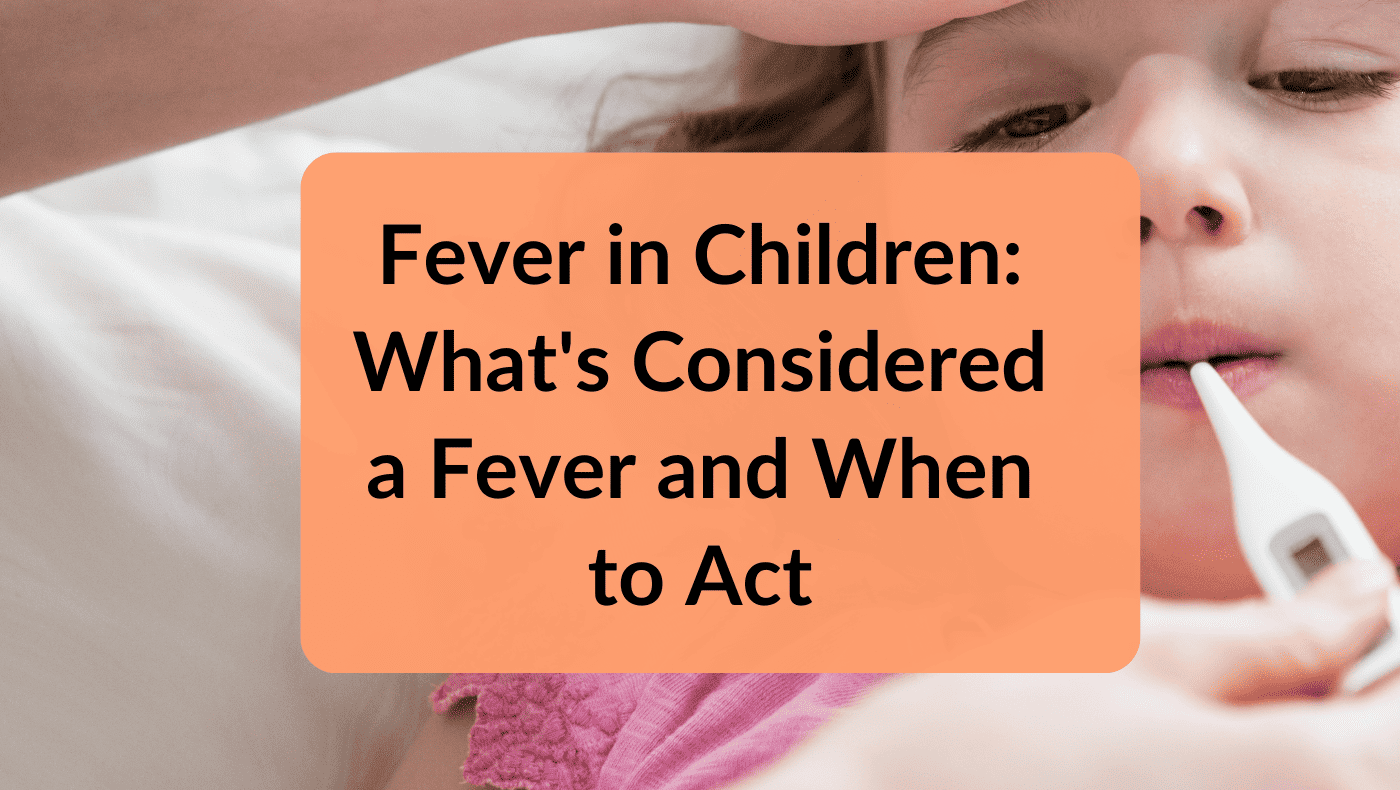Last updated on May 9th, 2024 at 07:41 am
Natural Fever Reducers for Kids: A Parent’s Guide
If you’ve ever had a child suffering from a fever, you know how worrisome it can be. Knowing the best way to help your little one feel better is paramount.
While over-the-counter medications may seem like an easy fix, many parents are seeking natural remedies and treatments for their children’s fevers that can be quite effective with fewer potential side effects.
In today’s blog post, I guide you on the research that has uncovered natural fever reducers for kids so that you can rest assured knowing there are safe and trusted alternatives available when needed.
What’s Considered a Fever in Kids?
The normal body temperature for children, similar to adults, typically ranges between 97°F (36.1°C) and 100.4°F (38°C).
Although minor fluctuations can occur due to factors such as time of day and physical activity, a child’s temperature is generally considered a fever when it surpasses the upper limit of 100.4°F (38°C).
Monitoring a child’s fever is crucial as it is often a sign that the body is fighting off an infection.
However, it’s also important to remember that a fever in itself is not a disease but a symptom, and the underlying cause needs to be addressed.
High or persistent fevers, or those accompanied by other alarming symptoms, warrant immediate medical attention.
Disclosure: There are affiliate links in this post. If you click the link and buy something, I might get a commission at no additional cost to you! This is what keeps this blog running so consider using these links if you decide to try any of my recommendations.
Natural Fever Reducers for Babies
 When it comes to infants, safety is paramount, and it’s important to consider gentle, natural fever reducers.
When it comes to infants, safety is paramount, and it’s important to consider gentle, natural fever reducers.
One recommended method is to keep your baby well-hydrated.
A steady intake of fluids can help lower a fever and prevent dehydration.
Breastfed babies should nurse more often, while formula-fed infants have regular formula and small amounts of water.
Another safe remedy is to dress the baby lightly. Overdressing an infant can trap body heat and cause the temperature to rise.
If your baby’s fever is not too high, a lukewarm bath can also help bring down the temperature – but never use cold water, as it can lead to chills.
In terms of dosing, for any natural remedies, always use minimal amounts and monitor your baby for any adverse reactions.
Despite these suggestions, it’s critical to consult a pediatrician before trying any new treatments.
Infants’ immune systems are still developing, and what works for older children may not be suitable for them.
Always remember, when in doubt, seek professional advice.
Natural Fever Reducers for Children
Older children, much like infants, can also benefit from a variety of natural fever-reducing methods.
One popular option includes herbal remedies such as chamomile, which is known for its calming properties and can help children rest.
Similarly, elderberry has been used traditionally to boost the immune system and may help the body combat fevers more effectively.
Homeopathic treatments, such as belladonna and ferrum phosphoricum, are also emerging as natural alternatives to reduce fever symptoms.
The diet also plays a significant role in managing a child’s fever.
Foods rich in vitamin C like oranges, strawberries, and bell peppers can help boost the immune system and potentially speed up recovery.
Likewise, hydration remains key. A sufficient intake of fluids, including water, coconut water, herbal teas, and clear broths, can help manage a high temperature by regulating the body’s heat.
Each of these methods, however, should be used with caution, as the appropriateness of treatments can vary by age, and individual responses may differ.
As always, while natural and home remedies can support recovery, consulting a healthcare provider is paramount to ensure the safety and effectiveness of any treatment regimen for your child.
When to Worry About Fever in Kids
While a fever often suggests that a child’s body is working to fight off an infection, parents should monitor certain signs and symptoms closely. It is vital to remain vigilant and know when to seek medical assistance.
Fever in kids when to worry- typically involves several key factors.
If your child’s fever persists for more than three days, even with the use of natural fever reducers, or if the fever is notably high (over 103°F or 39.4°C), medical attention is required.
Additionally, if the fever is accompanied by severe symptoms like persistent vomiting, unusual lethargy, difficulty breathing, severe headache, rash, or stiff neck, it is crucial to consult a healthcare provider without delay.
Remember, each child is unique and may exhibit fever symptoms in various ways.
It’s crucial to trust your instincts. While it’s natural to worry, remember that a fever is often a healthy sign that your child’s body is effectively combating an infection.
However, vigilance is key – don’t hesitate to seek professional help if your child’s symptoms seem severe or unusually prolonged. Your child’s health and well-being are always the priority.
Effective Strategies to Reduce Fever in Kids
When it comes to managing and reducing fever in kids, several natural, safe, and effective strategies can be employed:
- Proper Hydration: Ensure your child is drinking enough fluids, including water, herbal teas, and clear broths. Hydration not only helps cool the body but also prevents dehydration, which can occur when your child has a fever.

- Rest: When your child’s body is fighting off an infection, it’s essential for them to get plenty of sleep and rest. Rest assists the body in healing and recuperation.
- Cool Compress: Applying a cool compress to your child’s forehead can help reduce fever. Never use ice or extremely cold compresses as they can cause discomfort and chills.
- Light Clothing: Dress your child in light, breathable clothing to help heat escape from their body more easily.
- Herbal Remedies: Chamomile and elderberry are known for their fever-reducing properties and can be served as teas. Always consult a healthcare provider before trying new herbal remedies.
- Balanced Diet: Foods rich in vitamin C and other antioxidants can boost the immune system and aid recovery.
- Lukewarm Bath: A lukewarm bath can help cool your child’s body and reduce fever. Never use cold water as it can lead to chills. You can also add Epsom salt and apple cider vinegar to baths.
It’s important to remember that while these methods can help reduce fever in kids, they are not replacements for professional medical advice. High or persistent fevers warrant immediate consultation with a healthcare provider.
Lastly, while over-the-counter medications can be effective, they should be used with caution due to potential side effects.
Always prioritize your child’s comfort and well-being when considering various treatment options.
In conclusion, managing and reducing fever in children involves a careful balance of natural remedies and professional medical guidance.
Natural fever reducers such as herbal teas, proper hydration, ample rest, a balanced diet, and the application of a cool compress can effectively help manage a child’s temperature.
Meanwhile, it’s important to remember that these remedies, while helpful, are not substitutes for professional medical advice, particularly if a child’s fever is high, persistent, or accompanied by severe symptoms.
Therefore, being proactive, informed, and vigilant is paramount.
With an understanding of the different natural methods available, and when to seek professional help, parents can confidently navigate the often stressful experience of managing their child’s fever.
Trust your instincts, educate yourself, and never hesitate to consult a healthcare provider when in doubt. Your child’s well-being and comfort are, and always should be, your utmost priority.
Additional Resource:
- Discover Reliable Resources
- Items for Cold and Flu Season
- Tips to help your child be healthy this winter
- Listen to Your Kids: Understanding the Language of Their Discomfort





0 Comments